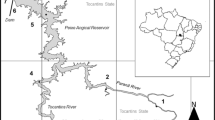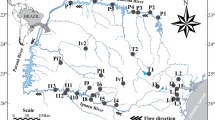Abstract
Spatial synchrony occurs when local populations exhibit correlated dynamics over time. Recent studies, both experimental and observational, have indicated that the magnitude of spatial synchrony, in cross-species analyses, is correlated with the level of specialization. In theory, specialist species would exhibit higher levels of synchrony than generalist species because they would be more sensitive to environmental variations. In addition, according to simulation studies, species with high growth rates should have more synchronized dynamics. In this study, we tested these hypotheses using datasets (phytoplankton populations and environmental variables) obtained in the Cana Brava Reservoir (State of Goiás, Brazil). We used a multiple regression model to test whether the average level of spatial synchrony was correlated with variables that indicate environmental specialization and population growth rate. In general, the average values of spatial synchrony were low, indicating the predominance of local factors in controlling population dynamics. We found no significant relationship between synchrony and our explanatory variables. To assess the generality of correlates of spatial synchrony, we suggest that future studies should focus on a common same set of explanatory variables.



Similar content being viewed by others
References
Anderson TL, Walter JA, Levine TD, Hendricks SP, Johnston KL, White DS et al (2018) Using geography to infer the importance of dispersal for the synchrony of freshwater plankton. Oikos 127:403–414
Burrows MT, Moore JJ, James B (2002) Spatial synchrony of population changes in rocky shore communities in Shetland. Mar Ecol Prog Ser 240:39–48
Carneiro FM, Nabout JC, Vieira LC, Roland F, Bini LM (2014) Determinants of chlorophyll-a concentration in tropical reservoirs. Hydrobiologia 740:89–99
Chevalier M, Laffaille P, Grenouillet G (2014) Spatial synchrony in stream fish populations: influence of species traits. Ecography 37:960–968
Cottingham KL, Carpenter SR (1998) Population, community, and ecosystem variates as ecological indicators: Phytoplankton responses to whole-lake enrichment. Ecol Appl 8:508–530
Defriez EJ, Reuman DC (2017a) A global geography of synchrony for marine phytoplankton. Global Ecol Biogeogr 26:867–877
Defriez EJ, Reuman DC (2017b) A global geography of synchrony for terrestrial vegetation. Global Ecol Biogeogr 26:878–888
Defriez EJ, Sheppard LW, Reid PC, Reuman DC (2016) Climate change-related regime shifts have altered spatial synchrony of plankton dynamics in the North Sea. Glob Chang Biol 22:2069–2080
Dolédec S, Chessel D, Gimaret-Carpentier C (2000) Niche separation in community analysis: a new method. Ecology 81:2914–2927
Dray S, Dufour A (2007) The ade4 Package: implementing the duality diagram for ecologists. J Stat Softw 22:1–20
Eaton AD, Clesceri LS, Franson MAH, Rice EW, Greenberg AE (2005) Standard methods for the examination of water and Wastewater. American Public Health Association, Washington, DC
Finlay BJ (2002) Global dispersal of free-Living microbial eukaryote species. Science 296:1061–1063
Gouhier TC, Guichard F (2014) Synchrony: quantifying variability in space and time. Methods Ecol Evol 5:524–533
Hanski I, Woiwod IP (1993) Spatial synchrony in the dynamics of moth and aphid populations. J Anim Ecol 62:656–668
Heino M, Kaitala V, Ranta E, Lindstrom J (1997) Synchronous dynamics and rates of extinction in spatially structured populations. Proc R Soc B Biol Sci 264:481–486
Karasiewicz S, Dolédec S, Lefebvre S (2017) Within outlying mean indexes: refining the OMI analysis for the realized niche decomposition. PeerJ 5:e3364
Koenig WD (2002) Global patterns of environmental synchrony and the Moran effect. Ecography 25:283–288
Kruk C, Huszar VLM, Peeters ETHM, Bonilla S, Costa L, Lürling M et al (2010) A morphological classification capturing functional variation in phytoplankton. Freshw Biol 55:614–627
Lansac-Tôha FA, Bini LM, Velho LFM, Bonecker CC, Takahashi EM, Vieira LCG (2008) Temporal coherence of zooplankton abundance in a tropical reservoir. Hydrobiologia 614:387–399
Legendre P, Borcard D (2018) Box–Cox-chord transformations for community composition data prior to beta diversity analysis. Ecography 41:1820–1824
Liebhold A, Koenig WD, Bjørnstad ON (2004) Spatial synchrony in population dynamics. Annu Rev Ecol Evol Syst 35:467–490
Litchman E, Klausmeier CA (2008) Trait-based community ecology of phytoplankton. Annu Rev Ecol Evol Syst 39:615–639
Lodi S, Velho LFM, Carvalho P, Bini LM (2014) Patterns of zooplankton population synchrony in a tropical reservoir. J Plankton Res 36:966–977
Lodi S, Velho LFM, Carvalho P, Bini LM (2018) Effects of connectivity and watercourse distance on temporal coherence patterns in a tropical reservoir. Environ Monit Assess 190:566
Lopes VG, Castelo-Branco CW, Kozlowsky-Suzuki B, Sousa-Filho IF, Souza LC, Bini LM (2018) Environmental distances are more important than geographic distances when predicting spatial synchrony of zooplankton populations in a tropical reservoir. Freshw Biol 63:1592–1601
Lund JWG, Kipling C, Le Cren ED (1958) The inverted microscope method of estimating algal numbers and the statistical basis of estimations by counting. Hydrobiologia 11:143–170
Marquez JF, Lee AM, Aanes S, Engen S, Herfindal I, Salthaug A et al (2019) Spatial scaling of population synchrony in marine fish depends on their life history. Ecol Lett 22:1787–1796
Moran PAP (1953) The statistical analysis of the Canadian Lynx cycle. Aust J Zool 1:291–298
Pandit SN, Kolasa J, Cottenie K (2009) Contrasts between habitat generalists and specialists: an empirical extension to the basic metacommunity framework. Ecology 90:2253–2262
Pandit SN, Kolasa J, Cottenie K (2013) Population synchrony decreases with richness and increases with environmental fluctuations in an experimental metacommunity. Oecologia 171:237–247
Pandit SN, Cottenie K, Enders EC, Kolasa J (2016) The role of local and regional processes on population synchrony along the gradients of habitat specialization. Ecosphere 7:1–11
Paradis E, Baillie SR, Sutherland WJ, Gregory RD (1999) Dispersal and spatial scale affect synchrony in spatial population dynamics. Ecol Lett 2:114–120
Paradis E, Baillie SR, Sutherland WJ, Gregory RD (2000) Spatial synchrony in populations of birds: effects of habitat, population trend, and spatial scale. Ecology 81:2112–2125
Rangel LM, Silva LH, Rosa P, Roland F, Huszar VL (2012) Phytoplankton biomass is mainly controlled by hydrology and phosphorus concentrations in tropical hydroelectric reservoirs. Hydrobiologia 693:13–28
Ranta E, Kaitala V, Lindström J, Helle E, Lindstrom J (1997) The moran effect and synchrony in population dynamics. Oikos 78:136–142
R Core Team (2018) R: a language and environment for statistical computing, 3.6.0. R Foundation for Statistical Computing, Vienna. https://www.R-project.org/
Reynolds CS (2006) The ecology of phytoplankton. Cambridge University Press, Cambridge
Reynolds CS, Huszar VLM, Kruk C, Naselli-Flores L, Melo S (2002) Towards a functional classification of the freshwater phytoplankton. J Plankton Res 24:417–428
Rhodes JR, Jonzén N (2011) Monitoring temporal trends in spatially structured populations: how should sampling effort be allocated between space and time? Ecography 34:1040–1048
Sæther BE, Coulson T, Grøtan V, Engen S, Altwegg R, Armitage KB et al (2013) How life history influences population dynamics in fluctuating environments. Am Nat 182:743–759
Souza ACC (2008) Assessment and statistics of Brazilian hydroelectric power plants: dam areas versus installed and firm power. Renew Sustain Energy Rev 12:1843–1863
Stenseth NC, Ehrich D, Rueness EK, Lingjærde OC, Chan KS, Boutin S et al (2004) The effect of climatic forcing on population synchrony and genetic structuring of the Canadian lynx. Proc Natl Acad Sci 101:6056–6061
Tedesco P, Hugueny B (2006) Life history strategies affect climate based spatial synchrony in population dynamics of West African freshwater fishes. Oikos 115:117–127
Vieira MC, Roitman I, Barbosa HO, Velho LFM, Vieira LCG (2019) Spatial synchrony of zooplankton during the impoundment of amazonic reservoir. Ecol Indic 98:649–656
Vogt RJ, Rusak JA, Patoine A, Leavitt PR (2011) Differential effects of energy and mass influx on the landscape synchrony of lake ecosystems. Ecology 92:1104–1114
Walter JA, Sheppard LW, Anderson TL, Kastens JH, Bjørnstad ON, Liebhold AM et al (2017) The geography of spatial synchrony. Ecol Lett 20:801–814
Xu Y, Cai Q, Shao M, Han X (2012) Patterns of asynchrony for phytoplankton fluctuations from reservoir mainstream to a tributary bay in a giant dendritic reservoir (Three Gorges Reservoir, China). Aquat Sci 74:287–300
Zanon JE, Rodrigues L, Bini LM (2018) Hard to predict: Synchrony in epiphytic biomass in a floodplain is independent of spatial proximity, environmental distance, and environmental synchrony. Ecol Indic 93:379–386
Zanon JE, Carvalho P, Rodrigues LC, Bini LM (2019) Potential mechanisms related to the spatial synchrony of phytoplankton is dependent on the type of data. Hydrobiologia 841:95–108
Acknowledgements
This research was funded by Coordination for the Improvement of Higher Level Personnel (CAPES; scholarships to MNS and RVG) and Brazilian Council of Research (CNPq; grants to LMB and LCR). This work was also developed in the context of the National Institutes for Science and Technology (INCT) in Ecology, Evolution and Biodiversity Conservation, supported by MCTIC/CNPq (proc. 465610/2014-5) and FAPEG.
Author information
Authors and Affiliations
Corresponding author
Additional information
Publisher's Note
Springer Nature remains neutral with regard to jurisdictional claims in published maps and institutional affiliations.
Handling Editor: Camilla CAPELL.
Electronic supplementary material
Below is the link to the electronic supplementary material.
Rights and permissions
About this article
Cite this article
da Silva, M.N., Granzotti, R.V., de Carvalho, P. et al. Niche measures and growth rate do not predict interspecific variation in spatial synchrony of phytoplankton. Limnology 22, 121–127 (2021). https://doi.org/10.1007/s10201-020-00640-0
Received:
Accepted:
Published:
Issue Date:
DOI: https://doi.org/10.1007/s10201-020-00640-0




